#Consecration of the Statue of Hermes
Explore tagged Tumblr posts
Text
Quotes in common speech related to Arsinoe Athenide, peeress of sagacity, patron of the family as well as the neglected/forgotten.
1) Crocus and Mulberries: a term used for couples or things paired in general that no assumes will go well together but they do. This stems from the crocus being Lord Hermes sacred flower since it was created from the body of his dead lover whom the flower is named after and how the flower was associated with joy and cheerfulness whereas the mulberry that represented dedication and endurance was the garden plant sacred to Arsinoe. Despite them being completely different types of plants they not only grew well together but also helped mutually for weaving/textiles since crocus was used to make saffron which apart from being a spice was also highly sought after for dying clothes and mulberries were primarily cultivated for silkworms, with their leaves serving as the sole food source for the silkworm. So in that sense Hermes and Arsinoe together make richly dyed silk.
2) Watch out for the octopus: in reference to how in the courting challenge for Arsinoe set by Athena, Hermes sent his sacred animal the hawk to steal an object but the hawk lost to the octopus that stole it under their nose. It's basically an 'expect the unexpected' or 'be ready for anything' type of quote.
3) As pleasing as coral: A phrase meaning you've given a gift that will be treasured forever. In ancient Greece, coral was used as a medicine for sterility as well as protection from evil and the sea. Those living near the sea often used dried coral to pay tribute to Poseidon so by that logic he'd totally agree when people start using it to carve statues of his little girl. The first one is said to have been made by the Greek hero Perseus (named after Perseleia). According to the legend Perseus, after killing Medusa, goes to wash his hands in the sea and the drops of the Gorgon's blood (which had the power to petrify men), depositing on marine plants, create coral red. The hero saw the new material when looking for driftwood to carve a tribute towards Lady Loyalty in gratitude for her help slaying Medusa and cut off a piece thinking it might be useful in his journey. Perseus carved it into a figure of Lady Reason because the carmine reminded him of the goddess's vibrant red hair and left it for her at the altar. The goddess was so pleased by the gift she blessed Perseus' bloodline to never lose their wits and wore coral around her neck the rest of her days.
4) Laugh not at nettles: A quote telling us to look past the first impression and work with the tools at hand instead of dismissing them. Whilst often seen as a weed in modern times nettles were actually fiercely valued in ancient times because they provided a cheap and durable source of fibers that were often twisted into rope, sails and clothing. (Unfortunately the romans later consecrated the plant to Mars because its fabric was used to make legionnaire uniforms). Arsinoe taught the mortals to create the first sails and ropes out of nettles in answer to their pleas to have a means to fix their ship to go home after greedy merchants raised the prices leaving them incapable of buying rope or material to mend the wind sails. When the goddess arrived disguised as a kindly beggar pointing to the wild stinging nettles growing at the creeks and said this would be their sails the sailors laughed at the idea until they saw how the beggar turned into lady Arsinoe and showed them the process of turning nettles into fiber they promptly used for their vessels. They begged forgiveness and offered sacrifices that appeased the goddess, then they discovered fruits packed in nettle leaves retain their bloom and freshness because the figs they'd wrapped in the leaves for extra rations did not spoil.
5) When the otter tames the hare: A more polite say of saying 'It's never going to happen'. This alludes to how hares and otters are not happy in domestic settings as well as their patron gods since for the ancient greeks neither Arsinoe or Hermes would let themselves be 'domesticated' in the meek little tradwife way even if they did get married cause they were often exploring, working and changing the mortal world rather than staying at Olympus.
#arsinoe athenide#lore building#greek mythology retelling#athenide au#athenide twins au#Hermes and Arsinoe#haunting the narrative
103 notes
·
View notes
Photo

Fedor Bronnikov, Consecration of the Statue of Hermes (1874)
* * *
“But you will ask, after what manner is this beauty of a worthy soul to be perceived? It is thus. Recall your thoughts inward, and if, while contemplating yourself, you do not perceive yourself beautiful, imitate the statuary; who, when he desires a beautiful statue, cuts away what is superfluous, smooths and polishes what is rough, and never desists until he has given it all the beauty his art is able to effect. In this manner must you proceed, by lopping what is luxuriant, directing what is oblique, and, by purgation, illustrating what is obscure; and thus continue to polish and beautify your statue, until the divine splendour of Virtue shines upon you, and Temperance, seated in pure and holy majesty, rises to your view. If you become thus purified, residing in yourself, and having nothing any longer to impede this unity of mind, and no farther mixture to be found within, but perceiving your whole self to be a true light, and light alone; a light which, though immense, is not measured by any magnitude, nor limited by any circumscribing figure, but is every where immeasurable, as being greater than every measure, and more excellent than every quantity: if, perceiving yourself thus improved, and trusting solely to yourself, as no longer requiring a guide, fix now steadfastly your mental view, for with the intellectual eye alone, can such immense beauty be perceived. But, if your eye is yet infected with any sordid concern, and not thoroughly refined, while it is on the stretch to behold this most shining spectacle, it will be immediately darkened and incapable of intuition, though some one should declare the spectacle present, which it might be otherwise able to discern. For, it is here necessary, that the perceiver and the thing perceived, should be similar to each other, before true vision can exist. Thus the sensitive eye, can never be able to survey the orb of the sun, unless strongly endued with solar fire, and participating largely of the vivid ray. Every one, therefore, must become divine, and of godlike beauty, before he can gaze upon a god, and the beautiful itself.”
— Plotinus, Concerning the Beautiful
#Fedor Bronnikov#Consecration of the Statue of Hermes#Art#Beauty#Painting#Ancient Greece#Hermes Trimsegistus#Plotinus#Concerning the Beautiful#Wisdom#Thomas Taylor#Philosophy
41 notes
·
View notes
Text
THE ULTIMATE "greek-Bros" ARES HEADCANON CHARACTER POST!!!! with pictures

-He is a dorklord. This man will do everything to make you believe he's a serious threat, until something like Achilles bodies him like a linebacker and it takes him like 2 mins to get up again. But his game face only gets serious during an actual war time. That's when you'll feel he's being a different person entirely.
-He is a hyper violent, chaotic rowdy dork who's interests includes; fighting, sparing, horsing around, harassing Athena, harassing Hephaestus, hating anyone who makes a fool out of him (and not in a good fun way) eating meat and food in general to make every other god who doesn't physically eat anything uncomfortable, collecting interesting discarded pieces of armor and weapons, petting dogs, being in a relationship with Aphrodite, taking enough time to hangout with his many offspring, drink heavily with Dionysus, randomly join armies all over Greece to fight along side mortals, being a wild pig for several months on end than comeback just be a menace, get into bar fights with random people, polish his armor, sharpen his weapons, and ultimately avoid every single "Devine Princely" duty Hera and Zeus have him do...those duties end up going to Apollo for obvious reasons.
-If anyone can assume how old he is between his siblings based on appearance alone, Ares would be around 30-35 years of age, Hephaestus would be 29-34 years, Athena would be 28, Apollo and Artemis would be around 24-27 years, Hermes a close 24 and Dionysus would be 21. Dionysus and Ares were the only gods to age slower than their siblings. Athena being born an adult and Hermes having the fastest growth spurt.
-Inspite of his lack of maturity for his age, he's chronologically the eldest of all the first generation godlings. He was also the first godly to grow in a rather slow rate. In Human years, he would be aging 1 every 10 human years. This made things a little difficult for Hera and Zeus because after all he was their first child. There was a lot of expectations that didn't turn out so well for him. By the time Athena was "born", he was just newly consecrated as a god of war (Age 13 in god years). After a short amount of time, his title was shared between him and Athena. Than after a little while, he noticed his title of war god was becoming more and more....thinned out. His status as a war god is even questioned by other war gods.
-He was a very sweet, active and somewhat complicated child when he was younger. He often acted like what normally toddlers would but he would have his quirks, one of which that although he would be willing to fight gods bigger than him, he would cry for hours if he accidentally hurt someone when he didn't mean to. It didn't help that he grew up without any proper friends, that only happened when he got older and got to know his half siblings better.
-Ares is the god of war but he personally believes he's a "aspectless god" because of how the title of God of War is thrown around in Olympus. There's Athena (the wise, cold calculating goddess of war everyone loves so much), Kratos (a demigod who seems to be more skilled at weapons than he is), Enyo (his twin "sister" that apparently he knows nothing about) and several titans. So he's already feeling like he's become either useless or purposeless, so how does he solve this? He just does whatever he fucking wants to, he's so over being a war god that he just wants to fight until he takes a nap or something.
-the title of "Consumed by Women" was something of a mystery for the longest time. On one hand, Ares claims it's because he literally more popular with female mortals, on the other hand according to Dionysus (in an unironic and straightforward way), it could also mean Ares is the only god that "it's the most suckable". Aphrodite hates this title because that actually implies there is a woman who can do more for Ares than she does.
-This man is a dog man and will forever be a dog man, he will mildly tolerate cats but anything else is fair game.
-Although Athena is the goddess of wisdom, Ares may infact be considered a god of empathy and earned experience. Athena 's learned wisdom is considered a sign of intelligence and wit, but Ares knows about first hand experience and hes a visual learner rather than someone who reads instructions. He may not be book smart, but he knows a thing or two.
-He has the most lukewarm relationships in the family. Poseidon takes advantage of Ares when seafaring battles commence just so he can reap the rewards, Demeter is a little deterred by his brute nature when it comes to the effects of wars have on the environment that she often tries distances herself, Hestia actually tries her best to understand him, Hera loves him but there are somethings she wish she could change about him (much like any other parent would), Hades just gets upset at him because with war comes casualties and that comes with skewed numbers in Tartarus, Zeus's relationship with Area is tumultuous. Zeus has expressed time and time again how much Ares has disappointed him for various reasons.
- The same can't be said about his siblings, in contrast actually care for Ares. Apollo usually tries his best to be his conscience. Dionysus is his best drinking buddy, Hermes is a little more close to Ares due to him having the highest tolerance for Ares on a daily basis, Aphrodite loves him to bits, Artemis loves to mess with him, and many of the Titans don't really care much about him. The only gods who truly detest him is Hephaestus and Athena. Hephaestus for obvious and clearly understandable reasons... Athena only sees him as a "waste of space to throne of Olympus and a redundant bafoon whom has done nothing but create strife." (Quote Athena).
-Ares has an incredible soft spot for animals. His love for animals may have started when he was young. He one time accidentally killed a bird with his toy sword and cried for days. It took several days for Hera and Zeus to figure out what had happened. The best way the two reacted was Hera was actually moved by Ares being that guilty over a bird and Zeus (although pretty feeling the same thing Hera was feeling) pretty told him "cease your crying, you shall be doing the same thing to your enemies". Ares than learned a new emotional response to frustration; retaliation via pissing off Zeus on purpose.
-One of his favorite ways to wait out a "peace period" is go hog, literally. He shapeshifts into a boar for months on end until Artemis finds him. He has claimed to have been shot at nearly 114 times by Artemis.

-This is the manliest man that ever maned, he is the peak definition of what masculinity universally looks like. He's got hair to spare, he's 95% muscle and doesn't take things too seriously. For some however, he can't seem to grow a full beard, just a healthy amount of stubble. The only parts he shaves is any exposed skin, the reason is that he believes his body hair softens the friction between his his armor and his body. Apollo has been doing everything in his devine power to completely remove Ares's hair out of spite.
-Silly enough he's the only god that can be considered straight mostly because all of his more intimate relationships have been with women. He would like to try and see what it is like to have a relationship with another man tho. Sadly, the most successful relationship he has is with Aphrodite.
-He actually is considered a "visiting" king of Thrace. The wild folks of Thrace adore thier more "fancy looking" god king and worship him zealously. Spartans often take more time worship Heracles but Ares is also beloved.
-He has an unknown son in Sparta named Theo. He's the product of a relationship with a mortal woman who tricked an invading group of mercenaries into thinking that she was the most powerful warrior in her village after none of the Hoplites from her village returned from the Trojan war. Their story is a tale for another time.
-He hates Heracles. For embarrassing the living shit out of his most beloved twin sons Phobos and Deimos but also beating him up in front of his subjects in Thrace and embarrassing the shit out him.
-After his encounter with Otus and Ephialtes, became claustrophobic. He has trained himself to overcome his claustrophobia but to no avail.
-He will violate a man if they ever so harm a woman in anyway. After an unfortunate incident with one his beloved daughter at the hands of one of Poseidon's sons. He vowed to "mangle anyone who hurts his girls", but "his girls" he also had been referring to all women.
-Being the prince of gods isn't an easy task, no matter how easy Apollo makes it out to be. Ares had been brought rather similarly to all Grecian Royalty with a myriad of lessons, teachings, and princely duties. Ares at a certain age stopped trying and decided it was easier for him to go in life hated by much of his peers.... until a certain goddess came into his life.
-His love life is strange but surprisingly fruitful in the best way possible. Ares had some interesting relationships with several mortal women, at one point he tried something with Persephone when he was in his late teens.... Demeter nearly buried him in an early grave, Eos was one his first devine crushes (until Aphrodite cursed her to be forever horny on main 5ever 😔 so sad), a sizable amount of nymphs did get it on with him...but the one lucky lady who has permanently monopolized his penis is Aphrodite. She's not as sensitive about his lovers as Hera ...but she's warey of women Ares holds a special amount of attention to.
-Ares wants to believe he's in a normal relationship with Aphrodite, but after the Trojan war, he has since thought a little more deeply about his purpose with her. Aphrodite doesn't want to be tied in a marriage, yet he wouldn't mind being a more committed relationship, but he's also not that greatly comfortable with fucking his already strained relationship with Hephaestus as his biological brother and he's not really certain if half of his children with Aphrodite are even his....yet somehow he actually doesn't really care what she does. Ares understands that there will literally be nothing tying Aphrodite down and he respects her decision to do it....now if he only he can convince Hera of that.
-Hes a Mama's boy. When Zeus would be out having one of his affairs, Ares would make his life even more problematic just as a light revenge for hurting his mom.
-If he doesn't consider himself the god of war, he might as well consider himself the God of fathers because half of the time he's making time with his long list of children. Especially his many daughters, he knows a happy and supported daughter is an empowered one, and an empowered daughter makes for a good fighter. He has seen the potential women are capable of and has been criticized by Athena for purposing some "radical" ideas of women being "mildly respected". Zeus doesn't know what think of this expect that it's worth seeing Ares so something admirable and productive rather than roll around in gore all day.
-He loves just blending into random armies, but he loves joining what he preserves to be a "likely to lose" army. Just so he can have a challenge. If a war however has multiple groups, he just sits back and watches because he would just end up hopping from one group to another.
-Zeus had many doubts about Ares being his biological son....until he saw what bird he can change into, a species of vulture called the Cinereous vulture. As it turns out, looks like a scrunckly scrimblo version of an eagle. That, and 90% of Ares's terrible decision making, physical traits and impeccable talent with women.
-He can run and trot on all fours. The only other gods that can do this is Dionysus and Artemis.
-The relationship between him and Poseidon can be easily summed up by a stock image of Homer chocking Bart.
- Athena the literal moment she laid eyes of Ares was the very moment she considered Ares an obstacle. She literally has done nothing but do everything in her power to ruin his reputation as a legitimate war god of Olympus. Ares on the other hand literally does not give a flying shit about her or her opinion on him. Mostly because he has the one thing Athena fails to be able to do.... Empathize with others on an emotional level. Ares is the god of extreme emotion wether he likes to consider that or not.
-This man has dedicated his life to always sneaking into Tartarus to pet Cerberus. Cerberus literally doesn't mind this and let's Ares get near him... mostly because Ares never ventured past Cerberus's side when he visits so he's not actually breaking any rules ...Hades however keeps a close eye on him much like how one would keep on eye on some stranger's toddler when they're petting their dog.
-Ares can actually be found more traversing the wilds of Greece rather than Olympus or anywhere more metropolitan. Like Artemis, he enjoys the lack of human company and the peace of the outdoors.
-His relationship with Hephaestus is problematic at worst and complicated at best. Obviously like anyone who has a sibling who constantly fornicates with their spouse, Hephaestus wants nothing more than for Ares to go and end himself. Ares on the other hand, knows that what he does causes Hephaestus a lot of grief. But no man no matter how celibate they force themselves to be can't just say 'no' to Aphrodite. He has other reasons to dislike Hephaestus, such as the time Hephaestus trapped Hera on her golden throne, yet he can't help but be fascinatded by the prospect of having a biologically close brother who makes some interesting toys.
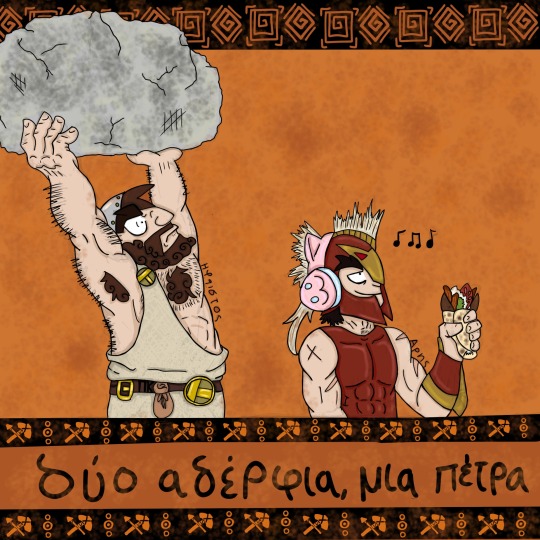
#greek mythology#hellenistic#greek gods#art#greek posts#greek bros#my art#greek myth memes#ares#hephaestus#character development
21 notes
·
View notes
Text
Russian Fairy Tales Test Prep: Pagan Deities
The best known roster of pagan deities is that of the six whose statues Prince Vladimir erected upon assuming sole rule of Kiev. According to the Primary Chronicle for the year 980, he “placed idols on a hill, outside the palace yard, a wooden Perun with a silver head and a golden mustache, and Khors and Dazhbog and Stribog and Simargl and Mokosh.” Missing from this list is Volos/Veles, the god of cattle (skotnii bog) and commerce, whose veneration in ancient Rus’ is widely attested, and by whose name (along with that of Perun) ancient Russians ratified oaths.
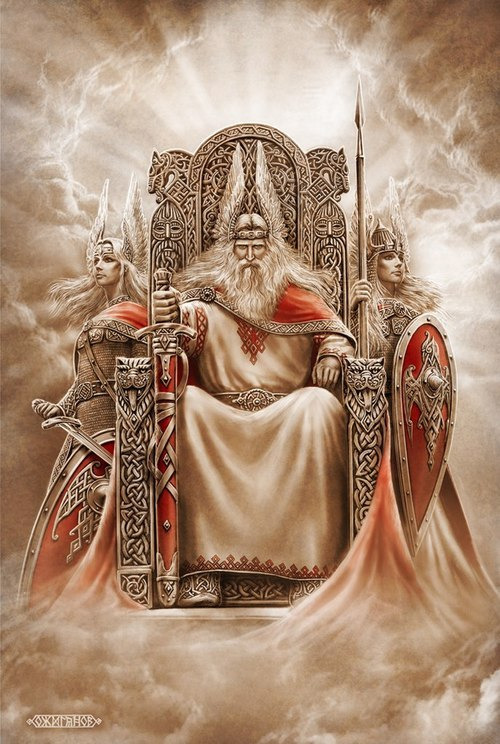
A. Perun/Bog
1. equivalent to: Lithuanian Perkunas, Latvian Perkons, Albanian Perendi, Roman Jupiter, Greek Zeus, Hittite Teshub, Norse Thor/Donar, Celtic Taranis. 2. primary sources: Nestor’s Chronicle, mid-6th century Procopius, 10th-century Varangian treaties 3. primary story: a creation myth, in which he battles Veles, the Slavic god of the underworld, for the protection of his wife (Mokosh, goddess of summer) and the freedom of atmospheric water, as well as for the control of the universe. 4. dvoeverie: After Christianization in the 11th century CE, Perun's cult became associated with St. Elias (Elijah), also known as the Holy Prophet Ilie (or Ilija Muromets or Ilja Gromovik), who is said to have ridden madly with a chariot of fire across the sky, and punished his enemies with lightning bolts.
In Slavic mythology: Perun was the supreme god of the pre-Christian Slavic pantheon, although there is evidence that he supplanted Svarog (the god of the sun) as the leader at some point in history. Perun was a pagan warrior of heaven and patron protector of warriors. As the liberator of atmospheric water (through his creation tale battle with the dragon Veles), he was worshipped as a god of agriculture, and bulls and a few humans were sacrificed to him. In 988, the leader of the Kievan Rus' Vladimir I pulled down Perun's statue near Kyiv (Ukraine) and it was cast into the waters of the Dneiper River. As recently as 1950, people would cast gold coins in the Dneiper to honor Perun.
Appearance & Reputation: Perun is portrayed as a vigorous, red-bearded man with an imposing stature, with silver hair and a golden mustache. He carries a hammer, a war ax, and/or a bow with which he shoots bolts of lightning. He is associated with oxen and represented by a sacred tree—a mighty oak. He is sometimes illustrated as riding through the sky in a chariot drawn by a goat. In illustrations of his primary myth, he is sometimes pictured as an eagle sitting in the top branches of the tree, with his enemy and battle rival Veles the dragon curled around its roots.
Perun is associated with Thursday—the Slavic word for Thursday "Perendan" means "Perun's Day"—and his festival date was June 21.
Reports: The earliest reference to Perun is in the works of the Byzantine scholar Procopius (500–565 CE), who noted that the Slavs worshipped the "Maker of Lightning" as the lord over everything and the god to whom cattle and other victims were sacrificed.
Perun appears in several surviving Varangian (Rus) treaties beginning in 907 CE. In 945, a treaty between the Rus' leader Prince Igor (consort of Princess Olga) and the Byzantine emperor Constantine VII included a reference to Igor's men (the unbaptized ones) laying down their weapons, shields, and gold ornaments and taking an oath at a statue of Perun—the baptized ones worshipped at the nearby church of St. Elias. The Chronicle of Novgorod (compiled 1016–1471) reports that when the Perun shrine in that city was attacked, there was a serious uprising of the people, all suggesting that the myth had some long-term substance.
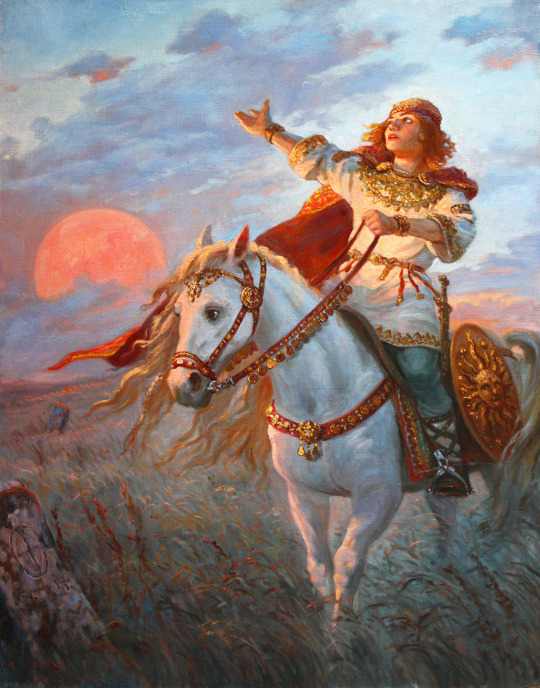
B. Kors/Xors/Chors
- most frequently mentioned Slavic god, after Perun - dvoeverie: appears in the apocryphal work Sermon and Apocalypse of the Holy Apostles, which mentions Perun and Khors as old men; Khors is said to live in Cyprus. Khors also appears in the apocryphal text Conversation of the Three Saints, a text which combines Slavic + Christian + Bogomil traditions. In it, he is referred to as “an angel of thunder” and it is said that he is Jewish. - his functions are uncertain and there are multiple interpretations of his name.
1. Sun God hypothesis: associated with Dazhbog; in The Tale of Igor’s Campaign, Prince Vseslav, who “came to Tmutarakani before the cocks" and "Khors ran his way", traveled from west to east and thus reached the castle before the cocks crowed, and in this way "overtook" the Sun; his name means “rays.”
2. Moon God hypothesis: Prince Vseslav was called “wolf” and his journey takes place at night when the sun is absent from the sky; his name does mean “rays” but they’re the moon’s rays and not the sun’s rays.
3. Fertility God/Vegetation hypothesis: link between Thracian & early Slavic cultures indicates Kors is more of a Dionysus-type figure, who dies and is risen; like Dionysus, Dazhbog (who Kors is often linked to) has a double nature (Eastern Slavs assign him solar qualities, while Southern Slavs assign him chthonic qualities).
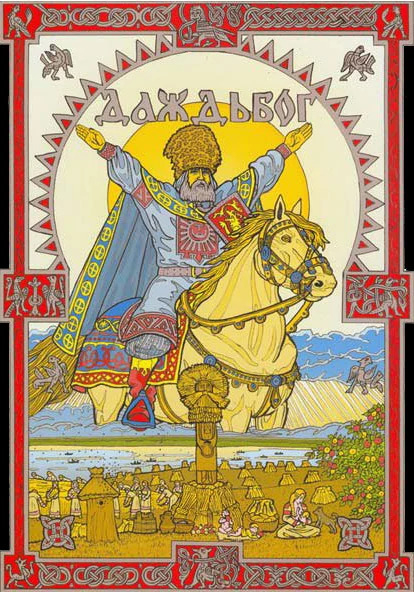
C. Dazhbog
1. equivalent to: Khors (Russian/Iranian), Mithra (Persian), Helios (Greek), Lucifer (Christian) 2. primary sources: John Malalas, The Song of Igor’s Campaign 3. family: Son of Svarog, brother of fire god Svarozhich, husband of Mesyats (the moon), father of the Zoryi and Zvezdy 4. primary myth: He resided in the east, in a land of everlasting summer and plenty, in a palace made of gold. The morning and evening auroras, known collectively as Zorya, were his daughters. In the morning, Zorya opened the palace gates to allow Dazbog to leave the palace and begin his daily journey across the sky; in the evening, Zorya closed the gates after the sun returned in the evening. 5. dvoeverie: There was a belief that each winter he would enter people's homes and gift gold to those who had been good. That belief passed into Christianity, especially in Serbia, and this visitor was called Položajnik. During Christianisation, his cult was exchanged with the cult of Saint Sava, while Dažbog became lame Daba - the most powerful demon in Hell. Reasons why he was demonized are various, possibly because his cult was the strongest in Serbia or because he was considered also as the god of Nav, the Slavic underworld and world of the dead.
In Slavic mythology: Dazbog was the Slavic sun god, a role that is common to many Indo-European people, and there is ample evidence that there was a sun cult in the pre-Christian tribes of central Europe. His name means "day god" or "giving god," to different scholars—"Bog" is generally accepted to mean "god," but Daz means either "day" or "giving."
His totem animal was a wolf, therefore wolves were sacred animals and killing them was considered a great sin. Wolves were considered to be messengers of Dazhbog, while he himself could shift into a white wolf.
According to one myth, Svarog became tired of reigning over the universe and passed on his power to his sons, Dazhbog and Svarogich.
Appearance & Reputation: Dazbog is said to ride across the sky in a golden chariot drawn by fire-breathing horses who are white, gold, silver, or diamonds. In some tales, the horses are beautiful and white with golden wings, and sunlight comes from the solar fire shield Dazbog always carries with him. At night, Dazbog wanders the sky from east to west, crossing the great ocean with a boat pulled by geese, wild ducks, and swans.
In some tales, Dazbog starts out in the morning as a young, strong man but by the evening he is a red-faced, bloated elderly gentleman; he is reborn every morning. He represents fertility, male power, and in "The Song of Igor's Campaign" he is mentioned as the grandfather of the Slavs.
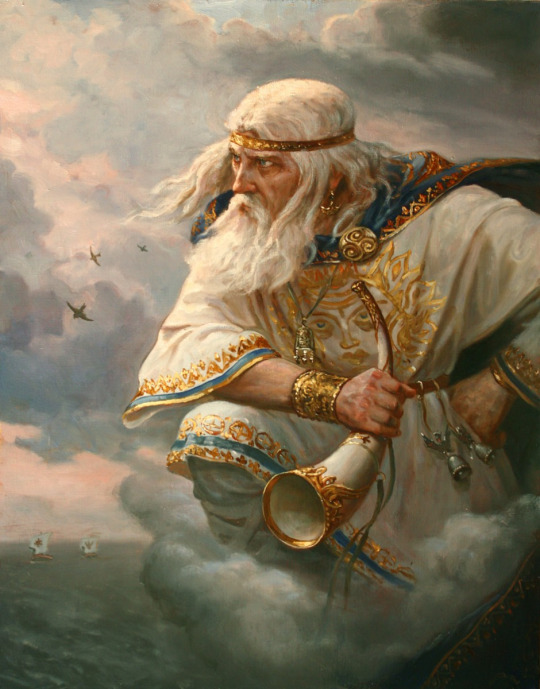
4. Stribog
Very little is known about him, although he was clearly very important to early Slavic peoples. In the epic ”Slovo o polku Igorove “ it is said that the winds, the grandsons of Stribog, blow from the sea. This leads to conclusion that Stribog is imagined as an old person, since he has grandsons. The grandsons were the winds from all directions.
Eagle was the animal consecrated to Stribog. Plants consecrated to Stribog were hawthorn and oak. When pledges were made, Stribog was often warrantor. Festivities in Stribog’s honor were organized in the summer as well as in the winter. They were probably organized in the summer in order to invocate winds and rain, while in the winter they were organized in order to appease him. In the period of Christianization Stribog’s characteristics were overtaken by St. Bartholomew and Stevan vetroviti (windy).

5. Simargl/Semargl
- may be equivalent to Simurgh in Persian mythology, who is portrayed similarly (winged lion and/or dog). He can also take human form. - God of physical fire (as opposed to celestial fire; that’s Svarog) - He is said to be the husband of Kupalnica (or Kupalnitsa), goddess of night, from whom he got two children: Kupalo and Kostroma.
Zorya, solar goddesses who are servants or daughters of the deity Dazhbog, keep Simargl chained to the star Polaris in the constellation Ursa Minor. Should he break free and destroy this constellation, it will cause the world to end.
Why would he be worshipped in Rus’, you ask? A couple of possible answers: a. Eastern Slavs borrowed Simargl from Sarmatian-Alanian people and worshiped him. b. Eastern Slavs never worshiped Simargl. Just at that time, a significant number of Kiev residents were of Khazar and Sarmatian-Alanian origin. Vladimir included their deity in the pantheon to get their support.

6. Volos/Veles (also Vlas, Weles Vlasii, St. Blaise, or Blasius)
1. equivalent to: Velinas (Baltic), Varuna (Vedic), Hermes (Greek), Odin (Norse) 2. primary sources: The Tale of Igor’s Campaign, old Russian chronicles 3. primary myth: a creation myth, in which Veles abducts Mokosh (the Goddess of Summer and consort of Perun, God of Thunder). Perun and his enemy battle for the universe under a huge oak, Perun's holy tree, similar to both Greek and Norse (Yggdrasil) mythologies. The battle is won by Perun, and afterward, the waters of the world are set free and flowing. 4. dvoeverie: Velia remains a feast of the dead in old Lithuanian, celebrating the border between the world of the living and the world of the dead, with Veles operating as a role of guiding souls to the underworld. The battle between Perun (Ilija Muromets or St. Elias) and Veles (Selevkiy) is found in many different forms, but in later stories, instead of gods, they are complementary figures separated from one another by a furrow plowed by Christ, who converts them. Veles is also likely represented by St. Vlasii, depicted in Russian iconography as surrounded by sheep, cows, and goats.
In Slavic mythology: A second creation myth associated with Veles is the formation of the boundary between the underworld and the human world, a result of a treaty forged between Veles and a shepherd/magician.
In the treaty, the unnamed shepherd pledges to sacrifice his best cow to Veles and keep many prohibitions. Then he divides the human world from the wild underworld led by Veles, which is either a furrow plowed by Veles himself or a groove across the road carved by the shepherd with a knife which the evil powers cannot cross.
Veles is associated with a wide variety of powers and protectors: he is associated with poetry and wisdom, the lord of the waters (oceans, seas, ships, and whirlpools). He is both the hunter and protector of cattle and the lord of the underworld, a reflection of the Indo-European concept of the netherworld as a pasture. He is also related to an ancient Slavic cult of the deceased soul; the ancient Lithuanian term "welis" means "dead" and "welci" means "dead souls."
Appearance & Reputation: Veles is generally portrayed as a bald human man, sometimes with bull horns on his head. In the epic creation battle between Velos and Perun, however, Veles is a serpent or dragon lying in a nest of black wool or on a black fleece beneath the World Tree; some scholars have suggested he was a shape-shifter. In addition to domestic horses, cows, goats, and sheep, Veles is associated with wolves, reptiles, and black birds (ravens and crows).
Reports: The earliest reference to Veles is in the Rus-Byzantine Treaty of 971, in which the signers must swear by Veles' name. Violators of the treaty are warned of a menacing punishment: they will be killed by their own weapons and become "yellow as gold," which some scholars have interpreted as "cursed with a disease." If so, that would imply a connection to the Vedic god Varuna, also a cattle god who could send diseases to punish miscreants.

7. Mokosh
1. loosely comparable to: Gaia, Hera (Greek), Juno (Roman), Astarte (Semitic) 2. epithets: Goddess Who Spins Wool, Mother Moist Earth, Flax Woman 3. primary sources: Nestor Chronicle (a.k.a. Primary Chronicle), Christian-recorded Slavic tales 4. dvoeverie: With the coming of Christianity into the Slavic countries in the 11th century CE, Mokosh was converted to a saint, St. Paraskeva Pyanitsa (or possibly the Virgin Mary), who is sometimes defined as the personification of the day of Christ's crucifixion, and others a Christian martyr. Described as tall and thin with loose hair, St. Paraskeva Pyanitsa is known as "l'nianisa" (flax woman), connecting her to spinning. She is the patroness of merchants and traders and marriage, and she defends her followers from a range of diseases.
In Slavic mythology: The origins of Mokosh as mother earth may date to pre-Indo-European times (Cuceteni or Tripolye culture, 6th–5th millennia BCE) when a near-global woman-centered religion is thought to have been in place. Some scholars suggest she may be a version of Finno-Ugric sun goddess Jumala.
Mokosh, sometimes transliterated as Mokoš and meaning "Friday," is Moist Mother Earth and thus the most important (or sometimes only) goddess in the religion. As a creator, she is said to have been discovered sleeping in a cave by a flowering spring by the spring god Jarilo, with whom she created the fruits of the earth. She is also the protector of spinning, tending sheep, and wool, patron of merchants and fishermen, who protects cattle from plague and people from drought, disease, drowning, and unclean spirits.
Although the Great Goddess has a variety of consorts, both human and animal, in her role as a primary Slavic goddess, Mokosh is the moist earth goddess and is set against (and married to) Perun as the dry sky god. Some Slavic peasants felt it was wrong to spit on the earth or beat it. During the Spring, practitioners considered the earth pregnant: before March 25 ("Lady Day"), they would neither construct a building or a fence, drive a stake into the ground or sow seed. When peasant women gathered herbs they first lay prone and prayed to Mother Earth to bless any medicinal herbs.
Appearance & Reputation: Surviving images of Mokosh are rare—although there were stone monuments to her beginning at least as long ago as the 7th century. A wooden cult figure in a wooded area in the Czech Republic is said to be a figure of her. Historical references say she had a large head and long arms, a reference to her connection with spiders and spinning. Symbols associated with her include spindles and cloth, the rhombus (a nearly global reference to women's genitals for at least 20,000 years), and the Sacred Tree or Pillar.There are many goddesses in the various Indo-European pantheons who reference spiders and spinning. Historian Mary Kilbourne Matossian has pointed out that the Latin word for tissue "textere" means "to weave," and in several derivative languages such as Old French, "tissue" means "something woven." The act of spinning, suggests Matossian, is to create body tissue. The umbilical cord is the thread of life, transmitting moisture from the mother to the infant, twisted and coiled like the thread around a spindle. The final cloth of life is represented by the shroud or "winding sheet," wrapped around a corpse in a spiral, as thread loops around a spindle.
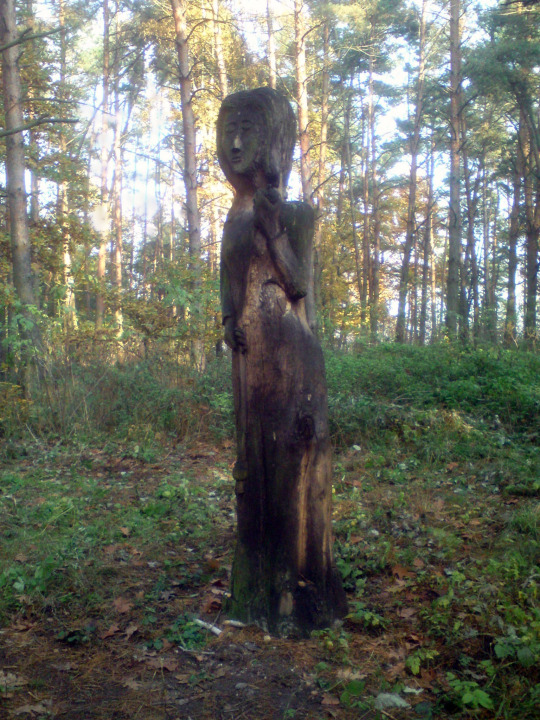
Our brief survey of agrarian holidays indicates that the peasant’s central concern is fertility and that special rites in the cemetery and/or rites involving a symbolic death & resurrection are a major component in these celebrations.
Belief in the absolute sanctity of “Mother Damp Earth” (Mat’syra zemlia) has been central to folk belief throughout the centuries. In remote areas, old people observed a ritual of asking the earth’s forgiveness prior to death into the 20th century. A number of scholars have maintained that peasants transferred attributes of earth worship to their particular veneration of Mary as “Mother of God.”
Fedotov: “At every step in studying Russian popular religion, one meets the constant longing for a great divine female power, be it embodied in the image of Mary or someone else. Is it too daring to hypothesize, on the basis of this religious propensity, the scattered elements of the cult of a Great Goddess who once...reigned upon the immense Russian plains?”
#Russian fairy tales#study blog#my notes#Slavic deities#slavic mythology#Russian paganism#russian folk belief
124 notes
·
View notes
Text
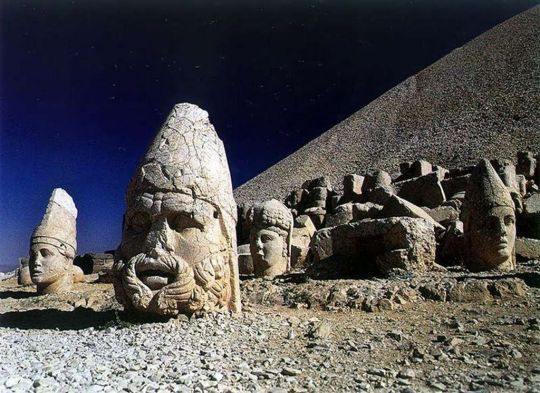

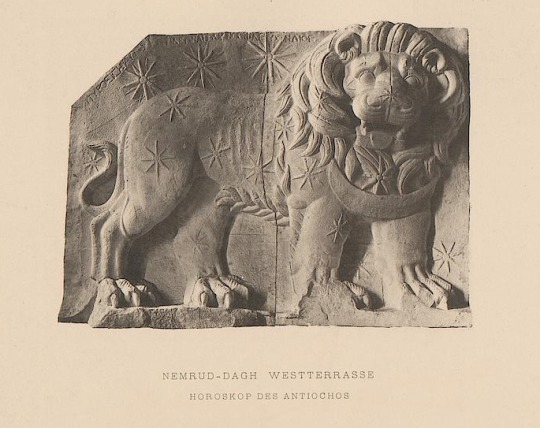

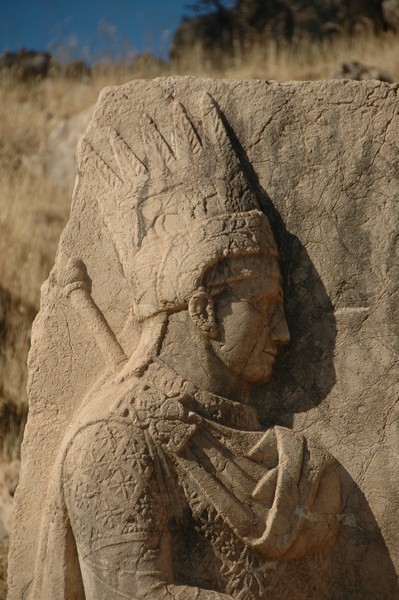
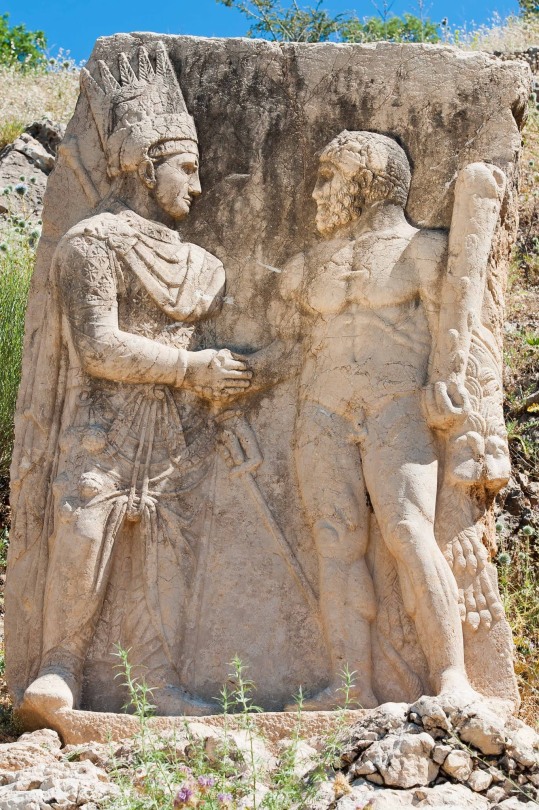
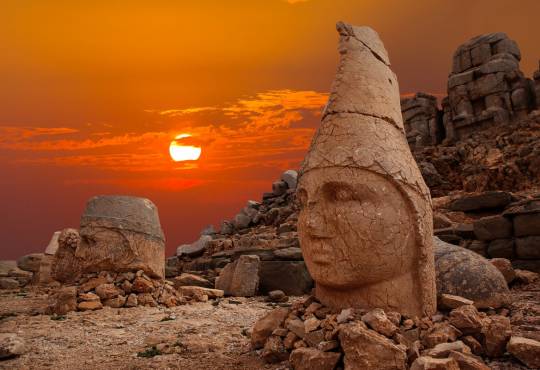
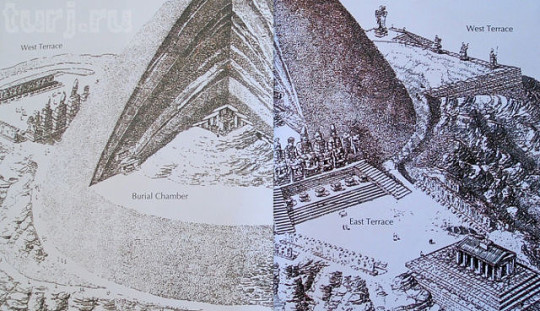
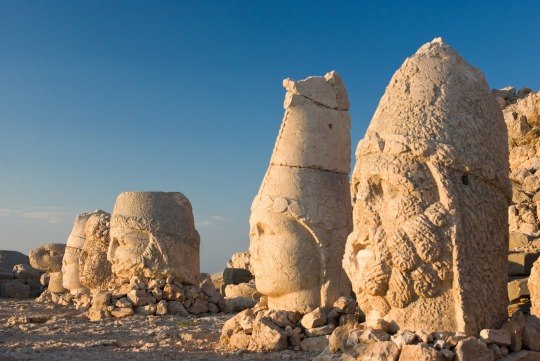
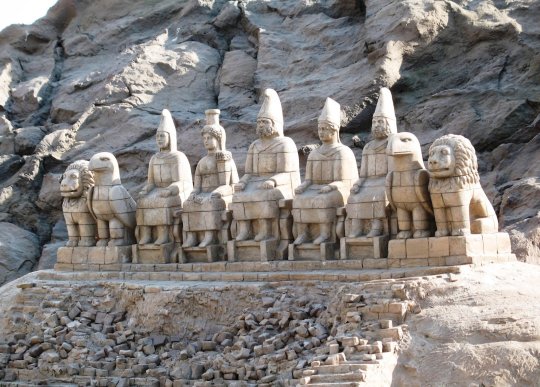
Statues of Mount Nemrut 62 BCE. The bottom picture is an artistic representation of what the monuments would look like restored. Left to right: Apollo, Tyche (fertility Goddess of the Commagene's), Zeus, Antiochus I Theos, and Herakles. The other images are the statues in their current state. The monuments were ordered constructed by Antiochus I Theos of Commagene, who was half Greek half Iranian. There are more images and descriptions on my blog, link at bottom.
"A large inscription is carved into the back of the colossal statues at the East- and West-Terrace. At the back of the Zeus statue, you can read the letters N O M O [ (Nomos). Here, the Holy Law of Antiochos begins. The Nomos of the Nemrud can be regarded as the testament of Antiochos.
...
The Great King Antiochos, the God, the Righteous One, the Manifest (Deity), the Friend of the Romans and the Greeks, the Son of King Mithridates Kallinikos and of Laodike the Brother-loving Goddess, the Daughter of King Antiochos Epiphanes, the Mother-loving, the Victorious, has recorded for all time, on consecrated pedestals with inviolable letters the deeds of his clemency.
I have come to believe that, for mankind, of all good things piety is both the most secure possession and also the sweetest enjoyment. This judgment became, for me, the cause of fortunate power and its blessed use; and during my whole life I have appeared to all men as one who thought holiness the most secure guardian and the unrivaled delight of my reign (or kingdom). By this means I have, contrary to all expectations, escaped great perils, have easily become master of hopeless situations, and in a blessed way have attained to the fullness of a long life. After taking over my father’s dominion, I announced, in the piety of my thought, that the kingdom subject to my throne should be the common dwelling place of all the Gods, in that by means of every kind of art I decorated the representations of their form, as the ancient lore of Persians and of Greeks–the fortunate roots of my ancestry–had handed them down (to us), and honoured them with sacrifices and festivals, as was the primitive rule and the common custom of all mankind; in addition my own just consideration has further devised still other and especially brilliant honors. And as I have taken forethought to lay the foundation of this sacred tomb, which is to be indestructible by the ravages of time, in closest proximity to the heavenly throne, wherein the fortunately preserved outer form of my person, preserved to ripe old age, shall, after the soul beloved by God has been sent to the heavenly thrones of Zeus Oromasdes, rest through immeasurable time,
…. so I chose to make this holy place a common consecrated seat of all the Gods; so that not only the heroic company of my ancestors, whom you behold before you, might be set up here by my pious devotion, but also that the divine representation of the manifest deities might be consecrated on the holy hill and that his place might likewise not be lacking in witness to my piety.
Therefore, as you see, I have set up these divine images of Zeus-Oromasdes and of Apollo-Mithras-Helios-Hermes and of Artagnes-Herakles-Ares, and also of my all-nourishing homeland Kommagene; and from one and the same quarry, throned likewise among the deities who hear our prayers, I have consecrated the features of my own form, and have caused the ancient honor of great deities to become the coeval of a new Tyche. Since I thereby, in an upright way, imitated the example of the divine Providence, which as a benevolent helper has so often been seen standing by my side in the struggles of my reign. Adequate property in land and an inalienable income therefrom have I set aside for the ample provision of sacrifices; an unceasing cult and chosen priests arrayed in such vestments as are proper to the race of the Persians have I inaugurated, and I have dedicated the whole array and cult in a manner worthy of my fortune and the majesty of the Gods. I have decreed the appropriate laws to govern the sacred observances thus established for everlasting, so that all the inhabitants of my realm may offer both the ancient sacrifices, required by age-old common custom, and also new festivals in honor of the Gods and in my honor. The birthday of my natural body, the sixteenth of Audnaios, and the tenth of Loos, the day of my accession to the throne, I have consecrated to the manifestation of the great deities, who were my guides in a prosperous beginning and have been the source of universal blessing for my whole kingdom.
Because of the multitude of offering and the magnificence of the celebration I have consecrated two additional days, each of them as an annual festival. The population of my empire I have divided up for the purpose of these assemblies, festival gatherings, and sacrifices, and directed them to repair by villages and cities to the nearest sanctuaries, whichever is most conveniently located for the festival observance. Moreover, I have appointed under the same title that, in addition to the observance just named, my birth on the sixteenth and my accession on the tenth shall be observed every month by the priests. Now that these regulations have been established, to be observed continually as the pious duty of men of understanding, not only in my honor but also in the blessed hope of their own good fortune, I have, in obedience to the inspiration of the Gods, ordered to be inscribed upon sacred, inviolable stelae a holy law, which shall be binding upon all generations of mankind who in the immeasurable course of time, through their special lot in life, shall successively be destined to dwell in this land; they must observe it without violation, knowing that the stern penalty of the deified royal ancestors will pursue equally the impiety occasioned by neglect as that occasioned by folly and that disregard of the law decreed for the honor of the heroes brings with it inexorable penalties. For the pious it is all a simple matter, but godlessness is followed by backbreaking burdens. This law my voice has proclaimed, but it is the mind of the Gods that has given it authority. NOMOΣ – LAW The priest who is appointed by me for these Gods and heroes, whom I have dedicated at the sacred tomb of my body, on the topmost ridges of the Taurus range, and who shall at a later time hold this office, he, set free from very other duty, shall without let or hindrance and with no excuse for evasion keep watch at his memorial and devote himself to the care and the proper adornment of these sacred images. On the birthdays which I have established forever as monthly and annual festivals of the Gods and of my own person, throughout the whole year he shall, himself decently garbed in Persian raiment, as my benefaction and the ancestral custom of our race have provided, crown them all with the gold crowns which I have dedicated as the sacred honors due the deified ancestors; and out of income from the villages, which I have designated for the sacred honors of the heroic race, he shall offer on these altars rich additional offerings of incense and aromatic herbs, and also splendid sacrifices in honor of the Gods and in my honor,
….. in worthy wise setting up sacred tables with appropriate foods and filling jars from the winepress with precious drink (that is, wine mixed with water). He shall hospitably welcome the whole of the assembled people, both the native and the foreigners who stream hither, and he shall provide for the common enjoyment of the feast by the assembled multitudes, in that, as is the custom, he shall take for himself a portion, as a gift in honor of the priestly office, and then distribute the rest of my benefaction to the others for their free enjoyment, so that during the holy days everyone may receive a never failing sustenance and may thus be able to celebrate the festival without running the risk of malicious calumny. The drinking cups, which I have dedicated, are to be used by them as long as they remain in the holy place and participate in the general assembly for the feast.
The group of musicians whom I have chosen for the purpose and those who may later be consecrated, their sons and daughters, and also their descendants shall all learn the same art and be set free from the burden of every other responsibility; and they are to devote themselves to the observances which I have established to the end, and without any evasion are to continue their services as long as the assembly requests it. No one, no king or ruler, no priest or official shall ever make slaves of these hierodules, whom I have, in accordance with the divine will, consecrated to the Gods and to my own honors, or their children or the descendants of their children, who shall continue their family to all later time; he shall neither enslave them to himself nor alienate them to anyone else in any way, nor injure one of them, nor deprive him of this ministry; but the priests shall take care of them, and the kings, officials, and all private persons shall stand by them, and the favor of the Gods and heroes will be laid up for them as a reward for their piety.
It is equally not permitted for anyone to appropriate or to alienate the villages which I have dedicated to these Gods, to sell them or to devote them to some other purpose, or in any way to injure those villages; or to reduce the income from them, which I have dedicated to the Gods as an inviolable possession. Nor shall anyone go unpunished who shall devise in his mind against our honor some other scheme of violence or of disparaging or suspending the sacrifices and festal assemblies which I have established. Whoever shall presume to rescind or to injure or guilefully to misinterpret the just tenor of this regulation or the heroic honors which an immortal judgment has sanctioned, him the wrath of the daemons and of all the Gods shall pursue, both himself and his descendants, irreconcilably, with every kind of punishment.
A noble example of piety, which it is a matter of sacred duty to offer to Gods and ancestors, I have set before the eyes of my children and grandchildren, as through many other, so too through this work; and I believe that they will emulate this fair example by continually increasing the honors appropriate to their line and, like me, in their riper years adding greatly to their personal fame. For those who do so I pray that all the ancestral Gods, from Persia and Macedonia and from the native hearth of Kommagene, may continue to be gracious to them in all clemency. And whoever, in the long time to come, takes over this reign as king or dynast, may he, if he observes this law and guards my honor, enjoy, through my intercession, the favor of the deified ancestors and all the Gods. But if he, in his folly of mind, undertakes measures contrary to the honor of the Gods, may he, even without my curse, suffer the full wrath of the Gods."
-The Nomos: The Holy Law of King Antiochus I Theos of Commagene
More images (tumblr only lets me upload 10 per post):
https://paganimagevault.blogspot.com/2020/04/statues-of-mount-nemrut-62-bce.html
#greek#ancient greece#iranian#persian#achaemenid#archaeology#zeus#apollo#tyche#herakles#antiochus#nemrut#pagan#european art#art history#antiquities#sculpture#statue#paganism#literature#1st century bce
126 notes
·
View notes
Text
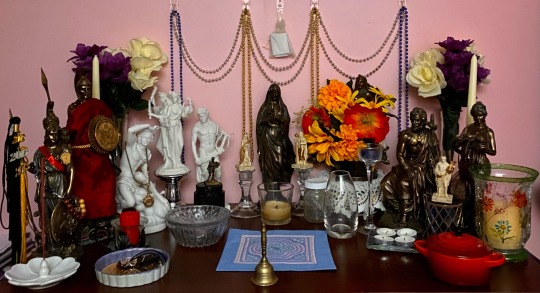
April 26th, 2022. Altar to Bless Hellenic Idols & Representations
"My stuff including idols, statues, and other items have all been packed away for awhile. I haven't liked most of my altars and shrines recently so I thought I'd cleanse all the representations & idols of the Gods. I'll have one altar for Sumerian and one for Hellenic." Explanation from previous altar post which was for the Sumerian Gods.
This is for the Hellenic Gods. Athena Ergane, Ares, Hestia, Hera Antheia, Askelpios, and Hygeia are all idols. I'm probably going to keep it that way and not consecrate any more, the rest will be blessed and offered as representations.
Left to right-ish is: Athena Ergane, Ares, Hermes, Hekate, Apollo Argyieus, Apollo Proopsios, Hera Oikos, Hestia, Zeus Herkeios, Zeus Ktesios*, Hera Antheia, Epione (blue candle), Asklepios, Akeso, Iaso, Panakeia, Aigle (4 white candles), Apollo Paian, Hygeia.
I really wanted Rhea here too, however I don't have a printer for the artwork I want so that'll be later on sometime.
#hellenic polytheism#paganism#helpol#altar#shrine#ofthetheoi#izkurereshkigal altars#i cannot fucking believe i was able to make an altar#i mean my back is now killing me but still im very happy#the altar feels so meh but that's exactly why I'm reblessing all my idols and reps#because i think thats why it feels meh#these gods are then split to four different altars/shrines#hence the 3 different apollo epithets#making altars is definitely much easier than writing prayers#physically more difficult but it comes so naturally that it doesn't take as much energy#if that makes any sense at all
11 notes
·
View notes
Text
“The Green Sojourn
In many traditions, the procuring of magical plant material from the wild is a rite unto itself, which sometimes reaches its apotheosis in a plant pilgrimage. Rites of ritual harvesting are an essential component to Green Sorcery and the Arte of the Philtre. These mindful praxes are a necessity for harvesting from the wild, and are rendered here as The Protocols of the Green Sojourn.
The first of the Laws of the Green Sojourner is the Protocol of Purity, which demands cleanliness of body, mind, tools, and intent prior to stepping foot in the wild. Every foray into wilderness is Exile, and thereby the domain of Cain. This hallow'd act entails a magical separation from the common, profane world and an entry into Earth Self-hallow'd; it also speicifcally mirrors the perpetual stance of the sorcerer as opposer. Thus awareness of this state of separateness should be cultivated and held at one's centre.
Before sojourning, clarity of intent should be first be formulated. Let the Verdant Magician be well-educated and cunning of craft regarding the species being sought: let all brothers and sisters of Arte discern keenly the status of the plant: know if it be endangered or overharvested; an aggressive introduced species or a precious native one. Knowing the Land is essential. If unfamiliar with the environs, let the land first be scouted, noting impressions received from the Genii Loci , plant communities, and apparent human impact. The Magician's Design should be humbly spoken to the local sprites, followed by an honest read of the place: any work of Green Sorcery can be thwarted by offended Land Spirits. As much as one may desire to harvest from a vigorous patch of Nettles, the Arte will be profaned if ill omens go unheeded and the Tabu of the Wildwood is violated.
As much as the aforementioned considerations of Purity of Intent, cleansing of the Sorcerer's very corpus should commence prior to the Green Sojourn: the Protocol of Purity demands Immaculation , both of the body and the Tools of Arte. For the physium, let a ritual bath be undertaken, as well as a fast. Physically cleanse all regalia by fumigating with smouldering tree-resin or an incense compounded from the plants growing in the locale to be wandered. The Mind may be purified and attenuated by observing that most noble of virtues, Silence. Traditional herb-gathering methods prescribe certain taboos prior to gathering plants, such as avoidance of sexual activity or alcohol. Both of these prohibitions are of incalculable value, chiefly for the homeostasis of the Aethyric Body as a precondition for the Arte Magical, as well as a gesture of devotion and respect. In addition , supplication of one's Grand Famulus prior to The Work is well advised. Finally, the Protocol of Purity demands that the land , and thereby the plants taken from it, be pure. As a general rule, the further removed from the influence of mankind the better, but of course there are exceptions to this, as some Herbs prefer haunts close to the habitation of humans, or graveyards, or amid the ruinous settlements of men long dead. Avoid picking plants by heavily traffick'd roadsides; many Herbs will absorb some of the corrupt principles of these besmirched byways, shun as well ditches fouled by agricultural venoms. Paradoxically, it is plants virtuous in accumulating healthful minerals from the earth, such as Nettle, which also store poisons.
The second protocol, The Protocol of Presence, is a magical obligation of pure and total focus when gathering Herbs, in the Garden as in the Wild. When sojourning into Wasteland and Thicket , the Man of Arte must become as the Wild: elsewise one is an intruder. This requires consideration of the magical goal, namely the Herbs being sought, but also the locus in which they dwell: in this moment, the Sojourner enters Hallowed Ground, stepping into a mansion of many beings. The Sojourn can be interrupted or tainted by the presence of obnoxious and loud persons; avoid them at all costs.
Third is the Protocol of Hailing. Prior to harvesting the Herb, let the Green Sorcerer announce his intent in a respectful way to the individual. A greeting and prayer of request to the plant is largely a matter of the sorcerer's own choosing. There are numerous examples of this from varying magical traditions. From the ancient Graeco-Aegyptians we learn of a curious rite of herb-gathering . It begins with the purifying his body. He then sprinkles natron for purification and circumambulates the plant three times, fumigating the herb with pine resin. The wortcunner then burns the best Kyphi incense, prays, pours a libation of milk, and pulls up the plant while invoking the name “of the daimon to whom the herb is being dedicated and calling upon him to be more effective for the use for which it is being acquired.” The plant is then addressed with the solemn incantation:
You were once known by Kronos, you were conceived by Hera, you were maintained by Ammon, you were given birth by Isis, you were nour ished by Zeus the god of rain, you were given growth by Helios and the dew....As you have exalted Osiris , so exalt yourself and rise just as Helios rises each day. Your size is equal to the zenith of Helios, your roots come from the depths, but your powers are the heart of Hermes, your fibers are the bones of Mnevis, and your flowers are the eye of Horus, your seed is Pan's seed. I am washing you in resin as I also wash the gods even (as I do this) for my own health....I am Hermes, I am acquiring you with Good Fortune and with Good Daimon both at a propitious hour and on a propitious day that is effective for all things.
Following the incantation, the herbalist fills the hole vacated by the plant with seven seeds each of wheat and barley, mixed with honey, then with earth. In the Domain of English Wortcunning, Nigel Pennick reveals a simple, potent, and artful tree-hailing from praxes of East Anglian plant-wisdom, spoken prior to cutting an Aspen branch, which, as noted , can be adapted for any tree:
Karrinder!
Hail to thee, O Aspen tree.
Old lady, give me some of this wood,
And I will give thee some of mine,
When I grow into a tree.
Send your virtue into this branch,
That your strength will flow through it
For the good of all.
Ka!
There is much to be gain'd by tailoring each Hailing individually to suit the plant . Considerations of the character of the Genius, the nature of the magics for which the Herb is intended, and some form of gratitude are paramount.
The Fourth Protocol of the Green Sojourn is The Protocol of Appropriate Harvesting. A clean cut, made with a sharp knife, is far more respectful of the plant than simply tearing off a leaf or a branch. Indiscriminate ripping of parts creates jagged wounds, rendering an Ally susceptible to infections. To assure both hygiene and quality of plant material, clean the blade after each use with strong alcohol.
For cutting, the Tool of Our Arte is the working knife, sometimes called the Knife of the White Hilt, its handle inscribed with the sigils and talismans of the Green Sorcerer's famuli, having, in some traditions, a crescent blade. Better than any knife or sickle, however, is a good hand pruner, duly consecrated to The Work. Such tools are crafted by horticulturists with the health of the plant in mind, and fashioned to cause minimal damage, rather than subjecting an Herb or Tree to the clumsy cuts of a knife. Some traditional wortcunners recommend avoidance of iron blades for this purpose, as iron is thought to offend the plant.
This Tabu of old has some credence, especially as relates to smaller, dainty plants with delicate stems or blossoms such as Violet or Forget-Me-Not. For such worts, iron and steel are perhaps excessive in terms of their metallic potencies. However, the vast majority of horticultural hand-pruners are made with steel, so the possession of bronze, silver, or gold knives must needs arise by the sorcerer's own ingenium and the Good Favour of Tubalo-Cain. It should be remembered that stainless steel, in order to render it incorruptible, contains appreciable amounts of Nickel, Chromium, Vanadium, or Titanium.
Appropriate harvesting for trees is especially important. If taking bark in any significant quantity, attempt to locate a newly-fallen tree, perhaps felled by a recent storm. If such cannot be found, remove bark in small quantities from younger lateral branches. Girdling, that is to say, circumscribing the trunk with a cut, can kill a tree. Leaves from trees should be gather'd in early to late spring, as their Virtues change with the advent of Summer, and they begin producing Bitter Principles to ward off insects. When harvesting branches for wands, avoid cutting branches arising from the dominant trunk; instead, take branches from lateral leaders.
When all plant materials have been gather'd, let them be wrapp'd in silk and put into a bag specially encharmed for carrying freshly-gather'd Herbs. By no means allow the material gather'd to touch the ground, as its sorcerous Virtue escapes downward into the earth and renders the material unsuitable for use in our Arte.
The Fifth Protocol, that of Numbers, governs the amount of material taken. Never harvest an Herb if it is a single individual standing alone. Look for large, well-established populations, and gather variously-aged individuals. Leave the largest and most healthy plant; petitioning this individual directly for specific needs before proceeding to gather, being alert for ill signs.
In general, the following numbers apply to gathering plants in the Wild:
If harvesting an entire plant, a maximum of one tenth of the total individuals in one location.
If stem or root, one sixth of total individuals. When taking roots from perennials, strive for lateral root-branches and leave sufficient vertical and other lateral roots to ensure the plant's survival; cutting too close to a plant's crown can kill it.
If bark, harvest sparing material taken from divers, smaller branches or from trees downed by recent storms. Avoid taking bark from the main trunk of a tree.
If flowers or fruit, harvest from one fifth of total individuals present.
If seed, harvest from one-fifth of total individuals, scattering some of the seed harvested.”
—
Ars Philtron
by Daniel A. Schulke
#witchcraft#magic#traditional withcraft#sabbatic witchcraft#sabbatic tradition#cultus sabbati#sabbatic craft#grimoire#Ars Philtron#poison path#Daniel a. Schulke#herbalism#her Craft
125 notes
·
View notes
Text
What I gathered for Etruscan so you can use it for the vamps
[x],[2],[3],[4 18+],[5]
acale (Aclus): noun, June
ais, eis (pl. aisar, eisar), god
aisiu: adjective, divine, of the gods
aisna, eisna: adjective, divine, of the gods
al: verb, give, offer
alpan, alpnu: noun / adverb, gift, offering; willingly
alphaze: noun, offering
alumnathe: noun, sacred society
am: verb, to be
an (ana, ane, anc, ananc): pronoun, he, she
apa: noun, father
apana: adjective, paternal
apcar: noun, abacus
ar-, er-: verb, to make, move, build
*arac: noun, falcon
*arim: noun, monkey
ars-: verb, push away?
aska: noun, type of vase (Gk. askós)
athre: noun, building (Lat. atrium?)
ati, ativu: noun, mother, 'mummy'
ati nacna: noun, grandmother
avil: noun, yearC
-c: conjunction, and
ca: demonstrative, this
camthi: noun, name of a magistracy
cape, capi: noun, vase,container(cf. Lat. capio:?)
*capr-: noun, April
capra: noun, urn
*capu: noun, falcon
car-, cer-: verb, make, build
cecha: noun, sacred things, ritual, ceremony, priestly
zilch cechaneri: noun, a title (see zil etc.)
cechase: noun, name of magistracy
cehen: demonstrative, this one here
cela: noun, room (Lat. cella)
celi: noun, September
celu: noun, priestly title
cep-, cepen: noun, priestly title
ces-: verb, lie
cezp: numeral, 8?
cezpalch: numeral, 80?
ci: numeral, 3
cialch-, cealch-: numeral, 30
ciz: adverb, three times
cisra: noun, Caere
clan (pl. clenar): noun, son
cletram: noun, basin, basket, cart for offerings (Umbrian kletra)
cleva: noun, offering
clevsin: noun, Chiusi
creal: noun, magistrate
creice: noun, Greek (Lat. Graecus)
culichna: noun, vase, 'little kylix' (Gk. kylix)
cupe: noun, cup (Gk. kúpe:, Lat. cupa)
cver: noun, cvil, gift, offeringCH
*chosfer (gloss): noun, OctoberE
eca (see ca)
eleivana: adjective, of oil
aska eleivana: noun, vessel for oil (Gk. élaion)
-em: adposition, minus
enac, enach: adverb, then, afterwards
epl, pi, pul: adposition, in, to, up to
eslz: adverb, twice
etera, eteri: noun, foreigner; slave, client (serf?)
etnam: adverb, and, alsoF
*falatu (gloss, falado): noun, sky
fan-: verb, to consecrate?
fanu: noun, sacred place (Lat. fa:num?)
favi: noun, grave, temple vault (Lat. fauissa?)
fler: noun, offering, sacrifice
flerchva: noun, all the statues, offerings
flere: noun, divinity, god
flereS: noun, statue
frontac: noun, interpreter of lightning; see
trutnuth (Gk. bronte:?)
fufluna, see puplunaH
hanthin: adposition, in front of
hec-, hech-: verb, put, place in front of, add
herma, heramasva: noun, place, statue? (Gk. Hermes)
herme, hermu: noun, sacred society of Hermes *hermi- (gloss, Ermius): noun, August
hinthial: noun, soul, ghost, reflection
hintha, hinthu, hinththin: adposition, below
hus- (pl. husiur): noun, youth, children;
huznatre: noun, group of youths
huth: numeral, 6I
ic, ich, ichnac: adverb, how
ica, ika: demonstrative, this
ilu-: verb, activity of offering or prayer
in, inc: pronoun, it
ipa: pronoun, relative pronoun
ipe, ipa: pronoun, whoever, whatever
*ister (gloss: Lat. histrio): noun, actor
ita, itu: demonstrative, this
*itu- (gloss: itus or
ituare): verb, to divide? (Lat. Idus)L
lauchum: noun, king (Lat. lucumo:)
lauchumna: adjective / noun, 'belonging to a lucumo' (king or prince), palace
lautni: adjective / noun, 'of the family', freedman
lautnitha, lautnita: noun, freedwoman
lautun, lautn: noun, family, gens
lechtum: noun, vase for oil (Gk. le:kuthos)
lechtumuza: noun, little le:kuthos
lein- : verb,to die?
les-: verb, offer sacrifice
leu-: noun, lion
lucair: verb, to rule
luth: noun, sacred place
lup-, lupu: verb, to dieM
-m, -um: conjunction, and
mach: numeral, 5
macstrev: noun, name of magistracy
mal-: verb, to give, dedicate?
malena, malstria: noun, mirror
man, mani: noun, the dead (Lat. Manes)
manin-: verb, to offer to the Manes?
maru, marunu: noun, name of magistracy (Lat. maro:, Umbr. maron-)
masan, masn: noun, name of month?
matam, matan: adposition, above, before
math: noun, honey, honeyed wine
maruchva: noun, type of zilath
mech: noun, people, league
men-: verb, offer
methlum: noun, district
mi, mini: pronoun, I, me
mul-: verb, to offer, dedicate as an ex-voto
mulach, malak, mlach: noun, votive offering, dedication
mun-, muni: noun, underground place, tomb
mur-: verb, stay, reside
murS: noun, urn, sarcophagus
mutana, mutna: noun, sarcophagusN
nac: adverb / conjunction, how, as, because
neftS, nefS, nefiS: noun, grandson (Lat. nepos)
nene: noun, nurse, wet-nurse
neri: noun, water
nesna: noun, belonging to the dead?
nethSra: noun, haruspicina
netSvis: noun, haruspex
nuna: noun, offering?
nurph-: numeral, 9P
pachathur: noun, Bacchante, maenad
pachie-, pachana: adjective, Bacchic
pacusnaSie, pacuSnasie: adjective, Bacchic, Dionysiac
papa, papacs: noun, grandfather
papals: adjective / noun, of the grandfather: grandson
parnich: noun, magistrate
patna: noun, name of vase (Gk. patane, Lat. patina?)
penthuna, penthna: noun, cippus, stone?
pi, pul: adposition, at, in, through
pruch, pruchum: noun, lug (Gk. próchous)
prumathi, prumats: noun, great-grandson (Lat. pronepos)
puia: noun, wife
pul, see pi
pulumchva: noun, stars?
pupluna, fufluna: noun, Populonia
purth, purthne: noun, name of magistrate or magistracy; dictator?
put-, puth-: noun, cup, vase, well? (Lat. puteus, puteal)Q
qutun, qutum: noun, vase (Gk. ko:tho:n)R
rach-: verb, prepare
*rasenna, rasna: adjective, Etruscan, of Etruria
rath: noun, sacred thing
ratum: adjective, according to law (Lat. rite)
ril: adjective, aged, at the age of ... (years)
rumach: adjective, Roman, from Rome
ruva: noun, brotherS, SH
13 notes
·
View notes
Photo




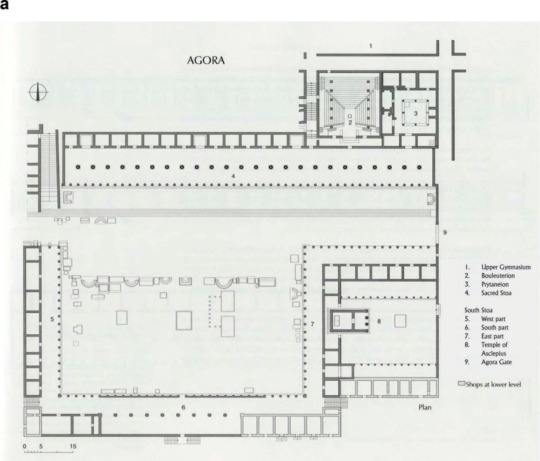
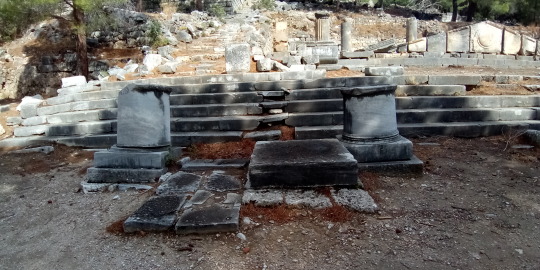


Agora of Priene & Sacred Stoa
Priene, Ionia, Turkey
3rd century BCE
Agora of Priene was an open place for people to meet, celebrate special days and festivals and commerce like any other Hellenistic city Agoras. So it had an important place in the daily life of ancient cities.
The Priene Agora was defined by Pausanias as being “a characteristic example of Ionic agoras.” It was built in the 3rd century BCE and has a horseshoe shape. One side is open and is surrounded, and the other side had a stoa. Both the east and west sides had 18 columns and on the south side 30 columns were constructed in the Doric style. There is a row of rooms (shops) at the rear parts of the south and west side of the stoa. The shops at the rear part of the east stoa remain in the temenos of the Asclepius Temple. From the middle part of the south side, some of the rooms were removed and this area was turned into a large hall.
The Sacred Stoa, the northernmost, was built by Ariarathes, the King of Cappadocia in the middle of the 2nd century BCE. It was 12 meters wide and 116 meters long. A 6-stepped stairway in the front opening onto the street leads to a wide gallery open to the sky. This gallery is 6.47 meters wide and had a marble-paved floor. There were benches on the east and the west side of the gallery of which one was exedra (a room in a public building furnished with seats) and the other in a horseshoe shape. The certain names from among the people of Priene were mentioned as inscriptions on the back of the seats.
The building is separated into two parts by columns. The wooden roof was supported by 49 Doric columns in the front row and 24 Ionic ones in the second row. There are fifteen rooms at the rear part; three of these are excellent stone workmanship of exedra design. R-The ninth room from the west was consecrated to the cult of Roman gods and Emperor Augustus which is understood from the inscriptions and drawings on the wall of this room. It is also understood that the Julian (Roman) calendar was begun to be used in western Anatolia in the year 9 BCE. It is believed that these rooms were used for the conversations of the State and the Athena Temple archives.
The statues in Agora in marble and bronze and created a very impressive atmosphere that represented the notabilities of the city. In ancient times there was an art gallery, but today only the bases of the statues remain and use the visitors for sitting.
The altar in the middle of the Agora was 6.20 meters long and 5.15 meters wide and dedicated to the god Hermes. The small agora is on the left of the agora which is a market place. It contains various foods, clothing, and other articles. During the excavations counters were revealed which was used for displaying the items on sale.
#art#Architecture#travel#history#agora#doric#priene#greek#greek art#Greek architecture#turkey#asia minor#stoa#3 bce#ionic
187 notes
·
View notes
Text
helvin's power of crossroads
(… from, Natasha Helvin's, Russian Black Magic, Destiny Books, 2019, pages 74-78)
Crossroads, such as intersections and forks, symbolize the difficulty of choice. The crossroads is the place where you ask: Which road should I take? Crossroads also symbolize uncertainty and loss of hope and longing for a lost shepherd, leader, or guide. In many cultures, a crossroads is a meeting place with transcendental forces (gods, spirits, the dead). The symbolism of the crossroads is like that of a door, marking the transition from the old to the new, from the earthly to the otherworldly.
Crossroads figure prominently in many cultures and traditions. Among African tribes, crossroads are often the place of ritual ceremonies. In Hinduism, the crossroads acted as a refuge for demons. The Romans prayed to household gods at crossroads. In ancient Rome, apart from the lares, patrons of domestic life, there were road gods, which were called Lares compitales. They guarded the wanderer from evil forces, and offerings to these road gods were made at crossroads as well.
For the ancient Greeks, crossroads bring a meeting with destiny. Statues of Hermes-Psychopomp, a spirit guide, stood at the crossroads. The god Hermes had many characteristics and represented many things. Hermes was the Olympic god of farmers and farms, travelers and hospitality, roads and trade, theft and love, prophecies and diplomacy, astronomy and astrology. He was also a god of science and wisdom, of art, of speech, of hope. And, most importantly: “God of writing.” He was the keeper of the crossroads and the entrances of the houses. He protected the trade, the travelers and the athletes. He had though, another talent.
He was Jupiter’s personal messenger, as well as the guide of the dead who led the souls down into the underworld. This last task required the fleet-footed Hermes to be able to cross the worlds with ease, which probably explains why he is also the god of crossing the border. His job was also to lead the souls of the dead to the entrance of Hades, where they waited for Harrodas to take. Hermes was the only Olympian god able to visit Heaven, Earth, and Hades, which enjoyed bragging to the other gods.
According to a Greek myth, the young Hercules sat at a crossroads, reflecting on his fate. It was then that the goddesses Arete (virtue) and Hedone (pleasure) appeared before him. The first offered the future hero a life full of difficulties and patience, which led to immortality; the second offered a path to joy and luxury. Hercules chose the first. In the famous Greek myth of Oedipus, it was at the crossroads that he met his father, whom he had never seen before and did not recognize, and killed him as the result of a quarrel.
The ancient Greeks believed that the three-headed goddess Hecate, who is associated with the realm of the dead and is the patroness of mages, ghosts, and witchcraft, appeared on clear nights in places where three roads converge. She is accompanied by spirits and howling phantom dogs. The Greeks left food at the crossroads for her. They turned to Hecate for help if someone was insane because it was believed that the spirits of the dead sent this disease to mortals.
Ancient crossroads were considered a symbol of the triple epiphany, combining three principles: active (good), neutral (productive or useful), and passive (harmful). For example, Hecate would shows the threefold aspect of a deity, embodying maiden, mother, and crone, and birth, fecundity, and death, as well as earth, sea, and sky. The crossroads is the symbol of choice in general and, in particular, the choice between life and death, as well as the sign of the transition from one space to another. As such, the crossroads is endowed with an ambivalent meaning.
On the one hand, this place was sacred. In Christianity, a crossroads, likened to a cross in its form, became the place of veneration of Christ. In the Middle Ages, crucifixes were placed at the crossroads of main roads to protect them from the presence of evil spirits. Christians erected crosses, chapels, and Madonna and other statues at crossroads.
On the other hand, the crossroads was considered to be the focus of harmful, impure forces. At the crossroads, witchcraft rituals were performed. In Europe, crossroads were seen as meeting places for mages and evil spirits. In Slavic mythology, the crossroads was considered a home for devils. Magical rituals often sought protection from the devil and demons at crossroads. In addition, the crossroads suggests the need to be particularly sensitive and cautious, because robbers often arrange ambushes at crossroads.
In Europe, there was a belief that you are likely to meet all kinds of playful creatures at the crossroads, including mages, who like to knock people off the right path. According to popular beliefs, ghosts also love crossroads. In German folklore there is a story about a crossroad in the town of Schleswig that ghost rider frequents. The neck of the rider’s horse stretches across the road and does not allow travelers to pass.
A legend popular in Pomerania, on the border of Poland and Germany, says that a traveler once stopped at night on a crossroads and saw a dark figure in front of him wearing long clothes and wooden shoes. To the traveler’s full amazement, the mysterious figure followed him home and settled in his house. Eventually, this man gathered his courage and spoke to the ghost. He asked the poor fellow to go with him to the cemetery so that he could say a few prayers and help the ghost to find eternal peace.
The spirits of the deceased appear near crossroads on the eve of All Saints’ Day (October 31), which was first a pagan and then a Christian holiday. On this day the barrier dividing the two worlds is believed to be the thinnest. Residents of Wales believe that a large number of spirits go to the crossroads on this night. In Europe, there are beliefs that on the eve of All Saints’ Day, the deceased form processions heading toward the homes of their living relatives, and a person who stands at a crossroads and puts his chin on a forked stick can see these processions.
In other cases, special spells make it possible to summon the spirits of the deceased to the crossroads. According to one ancient Danish rite, the person who needed to summon a spirit should go out at midnight on the eve of All Saints’ Day to the crossroads and stand inside a square formed by wagons. At the mention of his name, the ghost would appear and answer three questions.
Another belief was that some rituals performed at a crossroads on certain days (in particular, on the eve of All Saints’ Day) allow you to find out in advance who will die in the near future. For example, Welshmen believed that if a person went to the crossroads and listened to “the wind blowing over the feet of the dead” (the east wind), he would be able to hear sighs in those houses where people would die in the coming year. The highlanders of Scotland had a similar belief: if you sat on a three-legged chair at a crossroads, at midnight you would hear the names of those who were doomed to die in the near future. In German folklore, the same type of ritual was performed at the crossroads between eleven o’clock and midnight on Christmas Eve or on the eve of All Saints’ Day.
Traveling through crossroads had special significance in funeral rites. According to one ancient Welsh custom, the deceased were laid on the ground at every crossroads and read prayers over on the way from the house to the cemetery. Perhaps this was done to protect the deceased from evil spirits who chose such places for their visits and also, perhaps, to prevent the ghost of the deceased from returning to the house and interfering with the living. In Hesse, a central state in Germany, it was believed that the specter of the deceased would not return to the house if the dishes that belonged to him were broken at the crossroads. In Finland, participants of the funeral processions took the land from each crossroads they passed by and then scattered the land across the fields, thus protecting themselves from witchcraft (and ensuring a good harvest).
For many peoples, suicides were buried at intersections of roads. However, there are no intelligible explanations about this practice. Suicides were not allowed to be buried in Christian cemeteries. Perhaps this tradition is related to the fact that the cross formed by crossroads is associated with the consecrated ground of Christian cemeteries (where, as is known, no suicides were buried), or perhaps the reason for this is the desire to use the supernatural properties of intersections to prevent suicides from returning to life.
In many cultures, people believe that crossroads provide protection from ghosts. For example, one fairly common German superstition is that spirits cannot cross crossroads; thus, a person chased by a ghost or demonic being could shake his pursuer at a crossroads. As soon as the pursued person reached the crossroads, the spirit disappeared, issuing a completely inhuman scream. Similarly, the Irish believed that at the crossroads, fairy magic did not work and that mortals abducted by fairies could regain their freedom in such places.
Ancient Germans brought captured robbers to crossroads as a sacrifice to their gods, turning these places into a kind of scaffold. In medieval Germany, trials often took place at crossroads. According to later German law, it was legal to exact punishments at crossroads. In the Middle Ages, they traditionally buried executed criminals and those accused of witchcraft or suspected of vampirism at crossroads. The last, as a rule, were pierced through the chest with an aspen stake.
6 notes
·
View notes
Text

Creating a forest shrine to Dionysus
Above is the sacred tree that overlooks the Dionysus shrine I tend to in a secluded forest. I know it can be hard not having public temples, but even in antiquity temples for Dionysus were rare as much of his worship occurred outdoors. There are aspects of Dionysus you can’t connect to in a bedroom, or even in a temple.
So how can you get one?
First, you need to find a spot. This is the most difficult aspect of creating a public shrine. Unless you have your own forest in your backyard, you’re going to need to find a forest that where you’ll be able to worship in peace. Here’s some tips:
There are many public parks, even with extensive forest trails, that don’t see many people. Try visiting a different park each week near you and seeing what your options are
Once you find a spot you like, try and spend a few hours there to see how frequent other visitors are
Be open to going off trail, if you feel safe doing so, as there are often pockets of liminal space off the beaten path
You may wish to find a forest a little out of your neighborhood. That way, if you do encounter someone else when you are worshipping, it will be less likely to be someone you know
Stoners, teenagers, and bohemians are always finding secluded spots that have been used for drinking, smoking, and lovemaking. The saying ‘Sex, drugs, and Rock ‘n Roll’ is a modern equivalent of a Greek saying, ‘Wine, Women, and Song’, which refers to Dionysus, Aphrodite, and Apollo
In a way, these spaces have been consecrated to Dionysus through wine and drugs, to Aphrodite through lovemaking, to Apollo through music, and to Hermes through gambling and card games
As you are looking for your space, think about what your are going to use your shrine for. My shrine has a grove large enough for picnics or ritual dancing, and an old rocky outcropping nearby that can be used for religious theatrics. A creek running under ‘the theatre’, adds to the visual and auditory experience.
I’ve found a spot. Where do I go from here?
Once you find a spot, you can get started visualizing how you’d like to establish the shrine.
You may wish to perform divination to check with Dionysus and the local nature spirits to see if the area is suitable.
Clear out any litter you find at the spot. Not only is it the polite thing to do, but it will help you focus more on worship. Cleaning other areas in the forest is a nice offering to the nature spirits as well
Offerings you leave at the shrine can always disappear, so never leave anything that you aren’t comfortable losing.
Try and only leave small offerings, at least bringing in less than the regular litter you are taking out. Biodegradable is a plus, or at nondegrable items that pose little threat to the animals, such as ceramics or unbroken glass bottles. Don’t leave six pack rings, it makes baby Bacchus cry.
Consecrating the shrine
Now that the area has been chosen and cleaned, you can go ahead and consecrate it to Dionysus.
You can consecrate it at anytime, but you may wish to do it during a Dionysian holy day (Of which, being the god of festivals, there are many)
Statues are expensive and risk being broken or lost while in an outdoor setting, however, there is an ancient method of representing Dionysus that is cheap and easy
As seen above, place a mask on a tree. I prefer Mardi Gras masks, but anything will do. This is a Dionysian image used since antiquity
If you wish to add a fertility connection to the shrine, you can add a votive dildo or penis statue at the root of the tree. If you wish to add a festive connection to the shrine, you can throw Mardi Gras beads into the branches
Incense can be stuck into the dirt, you don’t even need an incense holder outside. If you leave empty wine bottles as offerings, these can be used to hold chime candles
As Dionysian as it would seem, don’t pour wine libations onto plants, including trees. This can kill them. Instead, offer them water
The consecration ritual is up to you. Bring your fellow Dionysians, or even an open minded friend, and recite prayers, make offerings, and celebrate the god of life!
32 notes
·
View notes
Text
Offerings /1
Although Hermes and Hecate were not always gods "worshipped at the same altar" (as in Rhodes) their worship near gates and roads often brought them closer together. It was often an expression of personal devotion.
The community of worship, depicted by Theopompus (5th century BC historian), consists in the choice of the same day of the month, namely, on the new moon - to crown and shine the statues - and to offer the same type of worship. offerings, incense, dough and cakes, apparently by the same double mode of consecration - by deposit and by fire - (...)
Several inscriptions speak of cooked offerings and Theopompus mentions cakes cut into pieces - and sacrificial cakes - (...) Indeed, cakes and pastry cakes ("delicacies", "pastries", "pasta masses", " breads") sometimes modeled in a symbolic form, must have been very usual dishes for the two deities.
--
"Paths of Hecate - Doors, roads, crossroads and other figures of the in-between" A. Zografou, p162
1 note
·
View note
Note
Hi! I have a silly question (I'm very new to all this): I've done a lot of research about offerings and what to do with them afterwards, and it's all been helpful- except, what if I want to offer pennies or other coins? What do I do with the coins afterwards? Do those stay on the altar? Is offering coins even a good idea? I want to make offerings but I don't have a way of respectfully disposing of food right now. Sorry for all the questions but thank you for the help!
Hey anon! Don’t worry about asking silly questions. Any newbie question is worth asking - that’s how we learn :)
I think offering coins is a perfectly good idea, not to mention that it’s historically attested. As for how to dispose of them, I have three suggestions:
You could keep them on your altar, or on a shrine. I’ve always found that permanent offerings, like flowers, coins, candles and so on make a worship place look beautiful and lived-in - it’s the trace of all your devotion. Of course, available space will eventually become an issue you’ll have to plan for.
In Ancient Greece, offerings were displayed for some time then removed to a back room, after which they were often used for the upkeep of the temple, to buy food for the priests, to renovate the precincts, and more. Metallic offerings (coins, bronze statues, iron swords, etc) were sometimes melted in times of need, either into money or into weaponry to defend the temple and its city. You could adapt this idea into your own practise by keeping your coin offerings in a box or drawer, and using them at a later date to buy a new statue, a nicer altar table, more candles, or anything else to honour your Gods. (Bear in mind, though, that these coins are still consecrated. They shouldn’t be used for non-religious reasons unless absolutely necessary.)
Instead of offering the coins at your altar, you could leave them places when you’re out and about. I mostly do this to honour Hermes. I will leave coins at crossroads, at bus stops, on ledges or park seats, in any places of passage where a lucky someone might find them. Sometimes I’ll give them directly to homeless people or street musicians. To me, it’s a lovely way of making an offering while paying it forward.
I hope this helps :) Good luck with your worship!
28 notes
·
View notes
Photo

Consecration of the Herm by Fyodor Bronnikov, 1874. A Herm is usually a head statue of the god Hermes aiming to show the way since Hermes is the patron deity of directions, or with apotropaic function aiming to dispel evil. #occult #hermes #westerntraditionalart #mercury http://ift.tt/2vldcaq
0 notes
Text
Representing the Elements on a Pagan altar
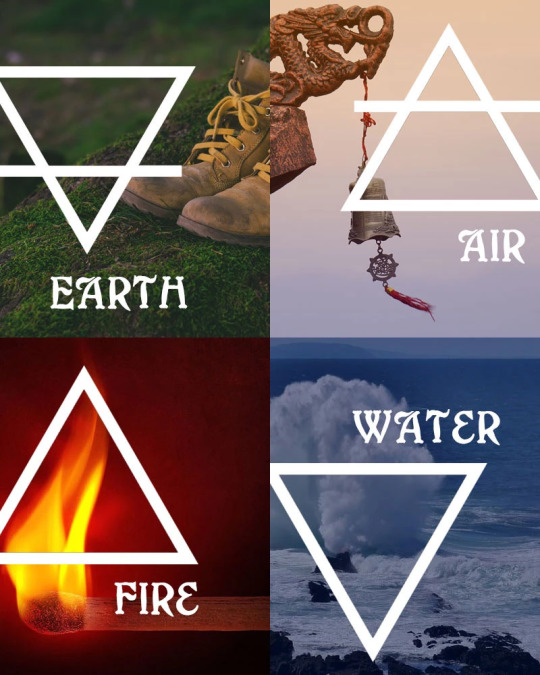
Posted by Michelle Gruben on Aug 11, 2017
Connecting to the powers of the Four Elements is a foundational practice for many Pagans. Earth, Air, Fire, and Water move through us and inspire us. As ideas, they help us to make sense of and to describe a complex world. Even the simplest of Pagan altars usually have some representation of the Elements.
Some Pagans have specific ritual tools consecrated to each one of the Elements. (The Wand, Cup, Disk, and Sword are the canonical tools of the ceremonial magician.) Others take a more spontaneous approach, grabbing everyday items that symbolise the elemental powers. There are traditional and non-traditional ways to evoke the four elements.
Speaking of which, there are no rules when creating an elemental altar. There is no such thing as a “perfect” elemental tool. Remember that every object you might find on Earth contains more than one elemental energy blended together. Just choose things that are meaningful to you and that appear harmonious when brought together. The lists provided below are suggestions only. (Your tradition may have others.)
Here are some different ways to represent the Elements on a Pagan altar:
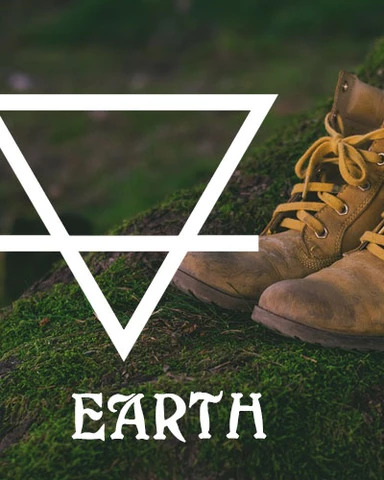
The Element: Earth
Traditional Tool: Pentacle or Disk
The meaning of Earth: Earth is perhaps the most overlooked Element in Pagan magick. Earth is everywhere, and it appears passive. It doesn’t really “do” anything with the same force as Air, Fire, or Water.
Yet the Earth gives us our birth. While we live, it sustains us. When we die, it covers us. Earth encompasses a multitude of magickal ideas: Nourishment, protection, obstruction, wholeness, stillness, plant and animal life, interdependence, prosperity and rest. The objects that can represent Earth are similarly diverse.
Altar Objects for Earth:
Pentacle
The altar (base) itself
Plate, paten, or disk
Ceramics
Cast metal
Coin
Rock or stone
Dish of soil, sand or salt
Food (especially fruits, vegetables or grain foods)
Flowers or herbs
Cauldron
Labyrinth
Gems (Garnet, Hematite, Jasper, Aventurine)
Candle (Green, brown, or black)
Deity statue (Gaia, Macha, Saturn/Chronos, Pan)
Horn or bone
Acorns
Seeds
Images of trees and mountains
Gnomes
Animal art (Cattle, Tortoise, Rabbit, Deer)
Oil (Patchouli, Vetivert, Evergreen)
Altar tile decorated with symbol of Earth
Tarot Ace of Pentacles
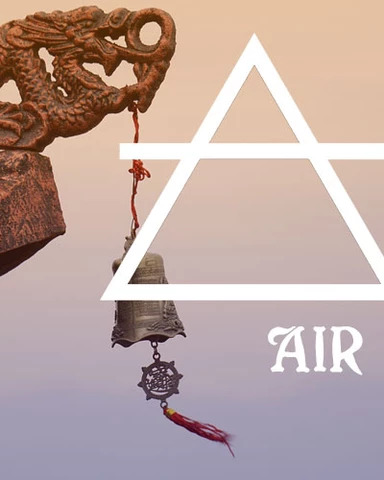
The Element: Air
Traditional Tool: Sword (or Wand, in some traditions)
The meaning of Air: As Air passes over the still Earth, the world moves into action and consciousness. Air is the Element of communication, exchange, and ideas. Air is invisible—we know it only through its effects on the world.
Air is also swift-moving, changeable and self-aware. It is the most human of all the Elements. Choose your Air items based on what Air means to you at the time you’re assembling the altar.
Altar Objects for Air:
Athame or sword
Wand or staff
Feather
Windchimes
Bell
Incense
Lamp or lantern (symbolising knowledge)
Fan
Book
Spoon or stirrer
Wheel
Wind-blown flowers and seeds
Brightly coloured ribbon or streamers
Crystals (Clear Quartz, Citrine, Smoky Quartz/Topaz)
Candle (Yellow or white)
Musical instrument (especially strings or woodwinds)
Images of clouds and sky
Animal art (Birds, Dragonfly, Butterfly)
Angels
Fairies
Air freshener or diffuser
Deity statues (Hermes, Thoth, Saraswati)
Oil (Eucalyptus, Peppermint, Lavender)
Altar tile decorated with symbol of Air
Tarot Ace of Swords
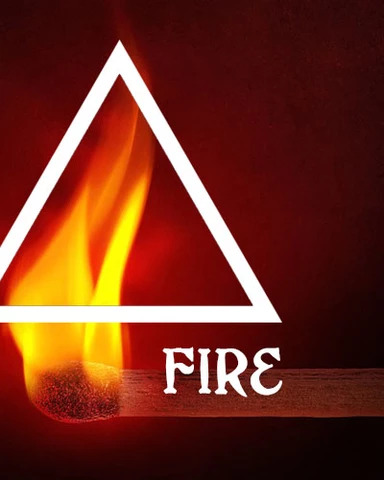
The Element: Fire
Traditional Tool: Wand (or Sword, in some traditions)
The meaning of Fire: Elemental Fire is the pure power of heat and light. The energy of Fire is strong, primal, and often dangerous. In Fire, we find the heat of passion and the warrior’s fighting spirit. Esoteric meanings of Fire include courage, willpower, lust, protection, spiritual aspiration, destruction and impending renewal.
Altar Objects for Fire:
Wand
Flame (candle, lamp, or brazier)
Lighter or matches
Spicy foods
Phallus
Incense
Cactus or thorns
Candle (Red, orange, or gold)
Dragons
Images of flames or the sun
Volcanic stones or ash
Bright yellow or orange plants
Gemstones (Ruby, Carnelian, Amber, Opal)
Pyramid
Djinn/Salamander
Oil (Cinnamon, Frankincense, Dragon’s Blood)
Deity statues (Ra, Vulcan, Brigid, Pele, Sekhmet)
Animal art (Lion, Lizard, Phoenix)
Altar tile decorated with symbol of Fire
Tarot Ace of Wands

The Element: Water
Traditional Tool: Cup
The meaning of Water: Water is the great partner of Earth in creating life as we know it. Like Earth, Water appears gentle, but contains immense potential power. It is cleansing, calming, and healing. Elemental Water also governs the magick of love and emotion, intuition, pleasure, and introspection.
Altar Objects for Water:
Chalice, cup, or goblet
Beverages (especially water or wine)
Scrying bowl or crystal ball
Rainwater
Blessed or holy water
Seashell
Yoni
Driftwood or seaweed
Gemstones (Aquamarine, Lapis Lazuli, Sodalite, Amethyst)
Ankh
Mirror
Mermaids
Images of ocean, rivers, or lakes
Candle (Blue)
Oil (Rose, Lotus, Jasmine)
Animal art (Fish, Dolphin, Frog)
Deity statue (Poseidon, Aphrodite, Yemaya)
Altar tile decorated with symbol of Water
Tarot Ace of Cups
I hope you enjoy putting together your elemental altar
https://www.groveandgrotto.com/blogs/articles/representing-the-elements-on-a-pagan-altar
0 notes